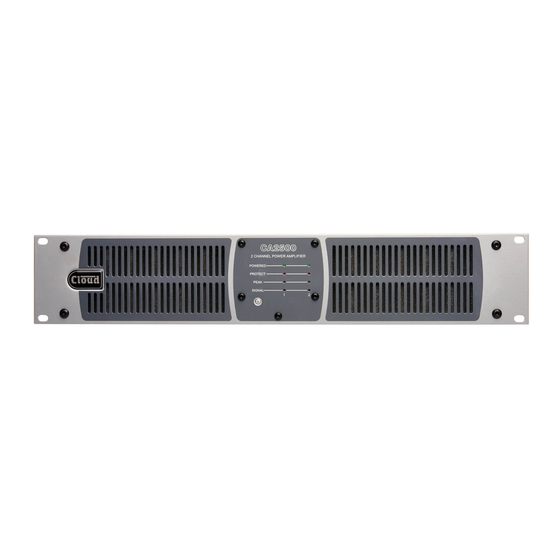Cloud CV2500 Technical Bulletin - Page 11
Browse online or download pdf Technical Bulletin for Control Unit Cloud CV2500. Cloud CV2500 13 pages. Cv series
Also for Cloud CV2500: Quick Start Manual (13 pages), Manual (15 pages)

exposed metal tops of any of the capacitors, or any other PSU or amplifier module circuitry, as there may
be residual high-voltages present. Any suspect capacitors can at this stage, however, be safely marked on
the top, using a plastic-bodied, Sharpie pen, or similar.
5. Using extreme caution, with the chassis lid still removed, reconnect the power, and ensure the amplifier is
switched on via the front panel. The temporary removal of mains power and associated prolonged
shutdown time, may have cleared some of the fault conditions, ie. any thermal or load-related protect
states.
6. Apply input signals as appropriate to "wake" the amplifier channels from APD standby, so that they receive
their high-voltage power, and their channel protect status can be properly displayed on the front panel
LEDs.
7. Determine which protect LEDs are now illuminated:
7.1. A single Channel in the "odd" or "even" channel group, or (excluding CA2250) a channel from each
group
The issue concerns the amplifier module for the amplifier channel which has the protect LED
illuminated. This amplifier module should be replaced.
Excluding CA2250, this scenario is also relevant to situations where there is more than one channel
from the "odd" or "even" group in protect, but where not all of the channel protect LEDs in that group
are illuminated. All modules showing protect should be replaced.
7.2. All channels in an odd (1, 3, 5, 7) or even (2, 4, 6, 8) channel group, or both channels in a CA2250
model.
The issue is likely a critical failure (e.g. DC protect failure, or short-circuit) of a single amplifier module
for one of the channels on PSU1 (odd channels in protect, or the amplifier is a CA2250) or PSU2 (even
channels in protect) and a process of elimination will be required to determine which module is
causing the condition.
Or, the issue may be due to an overloading or failure of the PSU1 or PSU2 modules, as determined by
whether the odd, or even channels are in protect. The CA2250, which only features PSU1, will show
both channels in protect if the PSU is overloaded. In this scenario, it is reasonable to start by assuming
a faulty amplifier module before considering a faulty PSU, unless the amplifier as a whole has been
exhibiting other abnormal operational behaviour alongside the channel protect condition.
7.3. All odd and even channels (not CA2250)
As 7.2, above, but there is a failure of a channel module on each PSU, or an overloading of both PSU1
and PSU2.
8. Where the presentation of protect LEDs at this stage, differs from that which was noted in step 1 above, it
may be necessary to later check the connected speaker wattage loadings of the other channels originally
in protect, as well as testing the speaker cabling for short-circuits. Protect conditions that have cleared
after the removal and restoration of the AC mains power supply, are not generally associated with actual
module failure.
9. Where some, but not all, amplifier modules on a given PSU have been identified as still being in protect,
then these modules should be replaced.
9.1. Follow the general PSU discharge procedure, described below, to ensure that the amplifier power
supplies are fully discharged.
9.2. Follow the procedure for removing an amplifier module, described below, to disconnect each of the
amplifier modules that are in protect.
